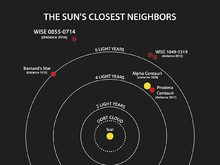Kinematics

All components of Alpha Centauri display significant proper motion against the background sky. Over centuries, this causes their apparent positions to slowly change. Proper motion was unknown to ancient astronomers. Most assumed that the stars are permanently fixed on the celestial sphere, as stated in the works of the philosopher Aristotle. In 1718, Edmond Halley found that some stars had significantly moved from their ancient astrometric positions.
In the 1830s, Thomas Henderson discovered the true distance to Alpha Centauri by analysing his many astrometric mural circle observations. He then realised this system also likely had a high proper motion. In this case, the apparent stellar motion was found using Nicolas Louis de Lacaille's astrometric observations of 1751–1752, by the observed differences between the two measured positions in different epochs.
Calculated proper motion of the centre of mass for Alpha Centauri AB is about 3620 mas (milli-arcseconds) per year toward the west and 694 mas/y toward the north, giving an overall motion of 3686 mas/y in a direction 11° north of west.note The motion of the centre of mass is about 6.1 arcmin each century, or 1.02° each millennium. The velocity in the western direction is 23.0 km/s and in the northerly direction 4.4 km/s. Using spectroscopy the mean radial velocity has been determined to be around 22.4 km/s towards the Solar System.
Since Alpha Centauri AB is almost exactly in the plane of the Milky Way as viewed from Earth, there are many stars behind them. In early May 2028, Alpha Centauri A will pass between the Earth and a distant red star, when there will be a 45% probability that an Einstein ring will be observed. Other conjunctions will also occur in the coming decades, allowing accurate measurement of proper motions and possibly giving information on planets.
Predicted future changesedit
Based on the system's common proper motion and radial velocities, Alpha Centauri will continue to change its position in the sky significantly and will gradually brighten. For example, in about 6,200 AD, α Centauri's true motion will cause an extremely rare first-magnitude stellar conjunction with Beta Centauri, forming a brilliant optical double star in the southern sky. It will then pass just north of the Southern Cross or Crux, before moving northwest and up towards the present celestial equator and away from the galactic plane. By about 26,700 AD, in the present-day constellation of Hydra, Alpha Centauri will reach perihelion at 0.90 pc or 2.9 ly away, though later calculations suggest that this will occur in 27,000 AD. At nearest approach, Alpha Centauri will attain a maximum apparent magnitude of −0.86, comparable to present-day magnitude of Canopus, but it will still not surpass that of Sirius, which will brighten incrementally over the next 60,000 years, and will continue to be the brightest star as seen from Earth (other than the Sun) for the next 210,000 years.
Comments
Post a Comment